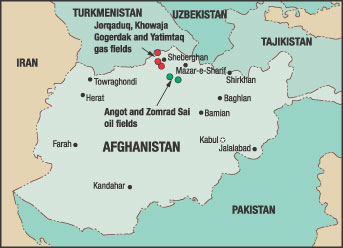International
Fate of small fields in northern Afghanistan up for grabsFor the second time in just over 10 years, the U.S. finds itself at war in the western half of Asia. Unlike the Persian Gulf War of 1991, when oil production was a major consideration in the liberation of Kuwait from Iraqi invasion, the situation in Afghanistan has little to do with energy. One could say that in the earlier war, the U.S.-led coalition was keeping the world safe for oil exportation. In the current conflict, however, the U.S. and its partners are striving for something fundamentally more basic – keeping the world safe from terrorism and ensuring the reign of freedom. Unlike 1991, the coalition forces are not fighting a highly organized state, nor are they fighting a conventional war. Indeed, they are taking on an enemy that seems to play by no rules at all, certainly not those of modern societies. As this column went to press, there was considerable talk in the Western media about what role the Afghan Northern Alliance would play in fighting Osama bin Laden and the Taliban. Much was also made of the potential concentration of fighting in northern Afghanistan and the possible roles to be played by the neighboring countries of Uzbekistan, Tajikistan and Turkmenistan. While watching television coverage in the U.S., I wondered what had become of the little oil and gas fields that the Soviets had so carefully nurtured near the Uzbek and Turkmen borders in the 1980s. Some searching through the resources available from the U.S. Energy Information Administration (EIA) and the U.S. Geological Service (USGS) provided some reasonably up-to-date answers. In a move that seems more than a little coincidental, EIA released a new "Country Analysis Brief" on Afghanistan in late September, just two weeks after the attacks on New York and Washington. EIA’s report says that there are still three natural gas fields capable of producing – Jorqaduq, Khowaja Gogerdak and Yatimtaq. All three of these are within 20 mi of the town of Sheberghan (see map). Gas production and distribution has been the responsibility of the Taliban-controlled Afghan Gas Enterprise. In 1999, repair work resumed on a distribution pipeline to the city of Mazar-e-Sharif. Spur pipelines to a small power plant and fertilizer plant also were repaired and completed. Mazar-e-Sharif now receives gas supplies from that line. In addition, several damaged gas wells at Khowaja Gogerdak field were rehabilitated, enabling output to increase there during the last year. According to USGS, Afghani gas output has averaged 920 MMcf to 950 MMcf annually, or about 2.5 MMcfd to 2.6 MMcfd. Meanwhile, a very small amount of oil is produced from Angot field near Sheberghan and processed at a topping plant in the town. The resulting boiler fuel is used in Sheberghan, Mazar-e-Sharif and Kabul. A second small oil field near Sheberghan, Zomrad Sai, recently was undergoing repairs. However, when the U.S./British-led coalition began its bombing campaign on October 7, the Northern Alliance’s equivalent of a foreign minister, Dr. Abdullah Abdullah, told a CNN reporter that Mazar-e-Sharif had been a primary target along with several other cities. He noted that the coalition’s bombing effort at that location had been particularly effective. So, one has to wonder what damage, if any, was sustained by either the gas pipelines or the producing fields. Furthermore, at the point that you, the reader, receives this issue, it will be interesting to see not only if such details emerge but whether it will become clear as to who has control of these assets.
Russian arctic fields to be developed. Gazprom Chairman Alexei Miller and Rosneft President Sergei Bogdanchikov will combine efforts to develop five major fields in Russia’s Yamalo-Nenetsk autonomous region and Timan-Pechora province of the arctic Barents Sea shelf. Their agreement provides f¾r joint development of Kharampurskoye (oil and gas condensate), Vyngayakhinskoye (gas and oil), Etypurovskoye (oil and gas), Prirazlomnoye (oil) and Shtokmanovskoye (gas condensate) fields. To implement the project, Gazprom subsidiary, ZAO Rosshelf, and Rosneft subsidiary, OAO Rosneft-Purneftegas, will establish a 50/50 joint venture and have their respective licenses reassigned to that new entity. Because Kharampurskoye, Prirazlomnoye and Shtokmanovskoye fields have been included in the list, and their mineral rights are granted on the basis of a production sharing agreement, the two firms have arranged to execute a PSA for these fields. Kharampurskoye contains estimated reserves of 1.15 billion bbl of oil and 26.5 Tcf of gas; Vyngayakhinskoye has 694 million bbl of oil and 3.7 Tcf of gas, Etypurovskoye holds 237.7 million bbl of oil and 10.6 Tcf of gas, Prirazlomnoye is estimated at 73 million bbl of oil, and Shtokmanovskoye has 202.5 million bbl of oil and 113.2 Tcf of gas. The collaborative efforts of Gazprom and Rosneft should significantly speed up development of these deposits in the Yamalo-Nenetsk autonomous region and Timan-Pechora oil and gas-bearing province.
|
- International Forecast: Some noticeable recovery is finally underway (September 2022)
- 2022 Forecast: Activity outside North America will lead global recovery (February 2022)
- The Last Barrel (October 2021)
- Oil and gas in the capitals (March 2020)
- Can a major war be won? (May 2019)
- World of oil and gas (February 2019)
- Applying ultra-deep LWD resistivity technology successfully in a SAGD operation (May 2019)
- Adoption of wireless intelligent completions advances (May 2019)
- Majors double down as takeaway crunch eases (April 2019)
- What’s new in well logging and formation evaluation (April 2019)
- Qualification of a 20,000-psi subsea BOP: A collaborative approach (February 2019)
- ConocoPhillips’ Greg Leveille sees rapid trajectory of technical advancement continuing (February 2019)




